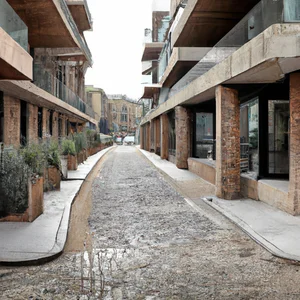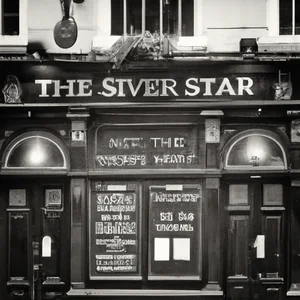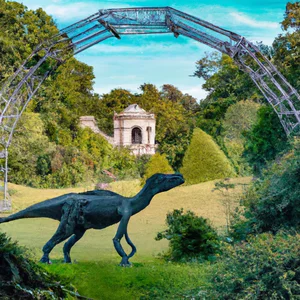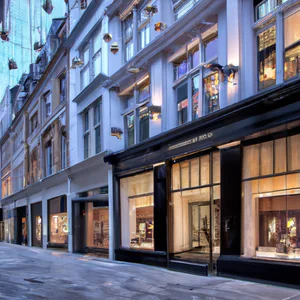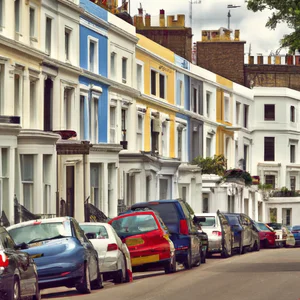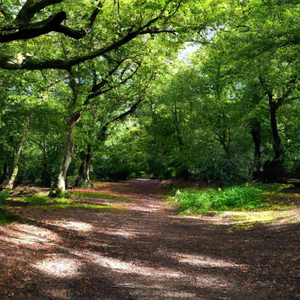Book your experience
Bloomsbury
Bloomsbury is a fascinating neighborhood in London, known for its rich history, distinctive architecture and vibrant cultural scene. Located in the heart of the British capital, Bloomsbury is a place where the past and present intertwine, creating a unique environment that attracts visitors and residents. This article aims to explore ten key aspects of Bloomsbury, offering in-depth insight into what makes this neighborhood so special. Let’s start with the Georgian architecture, which characterizes much of Bloomsbury’s cityscape. The elegant facades of the historic houses tell stories of a bygone era and reflect the lifestyle of its inhabitants. The British Museum, one of the world’s most important cultural institutions, is another key landmark, housing priceless collections that attract millions of visitors every year. Bloomsbury is also famous for its gardens, green spaces that offer a refuge from the bustle of the city and an ideal place for peaceful walks. The universities and educational institutions in the neighborhood contribute to a vibrant intellectual atmosphere, making it a hub of learning and innovation. Culture and literature have deep roots in this neighborhood, which has been home to many renowned writers and artists. Markets and shops offer a unique shopping experience, while restaurants and cafes present a variety of dining options that reflect the city’s diversity. Additionally, Bloomsbury hosts events and festivals that enliven the community, making it a vibrant and welcoming place. Its accessibility via efficient public transport makes it easy to visit, while family-friendly activities ensure that even the youngest can have fun and explore. Through these ten points, we will immerse ourselves in the heart of Bloomsbury, discovering its wonders and peculiarities.
Georgian Architecture of Bloomsbury
Bloomsbury, an iconic neighborhood in London, is known for its distinctive Georgian architecture, representing one of the most fascinating periods in British architectural history. The Georgian style, characterized by harmonious proportions and elegant details, had a significant impact on the appearance of this area in the 18th century.
Characteristics of Georgian Architecture
The Georgian houses of Bloomsbury are easily recognizable thanks to their red brick façades, arched windows and ornate doors, often flanked by columns. This architectural style emphasizes balance and symmetry, making the buildings particularly fascinating. The houses, generally terraced, are arranged along tree-lined streets, creating a quiet and tidy atmosphere.
Historical Importance
Bloomsbury played a crucial role in the development of Georgian architecture in London. Construction of many of its streets and squares began in the early 1700s, with urban planning aimed at creating a high-class residential community. Today, many of these buildings have been restored and preserved, allowing visitors to appreciate the beauty of this historical period.
Exploring Bloomsbury
For those wishing to explore Bloomsbury's Georgian architecture, a stroll along Russell Square and Bloomsbury Square is highly recommended. These public spaces are surrounded by some of the area's most beautiful buildings, offering unique photography opportunities and an immersion in London's architectural history. Don't forget to also visit Gordon Square, which is home to a number of historic houses linked to important literary figures.
Conclusion
In summary, Bloomsbury's Georgian architecture is not only an example of elegance and refinement, but also an important testimony to London's social and cultural history. Walking through its streets, you can perceive the legacy of an era that left an indelible mark on the architecture of the British capital.
British Museum
The British Museum is one of the most important and prestigious museums in the world, located in the heart of Bloomsbury, London. Founded in 1753, the museum houses a vast collection of over 8 million objects that tell the story of humanity and its cultures through the millennia.
History and Foundation
The British Museum was inaugurated as the world's first national museum, designed to be accessible to all, not just a small elite. Its collection has grown thanks to explorations, donations and acquisitions, collecting finds from every corner of the planet.
Architecture and Design
The museum is a masterpiece of neoclassical architecture, designed by the architect Sir Robert Smirke. The main entrance is characterized by an imposing portico with Doric columns, while the Great Court, a vast internal area, is covered by an extraordinary glass and steel dome, designed by the architect Foster and Partners. This space was inaugurated in 2000 and has transformed the accessibility of the museum.
Main Collections
The British Museum's collections range from ancient Egyptian art, with the famous Katebet mummy, to the treasures of ancient Greece, such as the Parthenon, to artefacts of British history. Each section of the museum offers a unique experience, with objects that tell stories of lost civilizations and living cultures.
Visits and Activities
The British Museum is free for most of its galleries, making it accessible to all. However, some temporary exhibitions may require an entrance fee. The museum also offers a variety of guided tours, workshops and educational activities for visitors of all ages. It is advisable to book in advance for special events or exhibitions.
Practical information
The British Museum is easily accessible by public transport, thanks to its central location. The nearest tube stop is Holborn, but it is also within walking distance of other stops such as Russell Square and Tottenham Court Road. The museum is open every day, with varying hours, and has cafes and gift shops for a complete experience.
Bloomsbury Gardens
Bloomsbury Gardens represent an oasis of tranquility in the heart of London, perfect for a relaxing break from the hustle and bustle of the city. These historic green spaces offer not only scenic beauty, but also an important cultural and social legacy.
History and Importance
The gardens date back to the 18th century and are an integral part of the Bloomsbury district, famous for its Georgian architecture and its proximity to important institutions. Originally, the gardens were designed as private areas for the residents of the surrounding elegant homes. Today, many of these gardens are open to the public, allowing residents and tourists to enjoy their beauty.
Famous Gardens
Among the best-known gardens in Bloomsbury are:
- Russell Square: This is one of the largest and most iconic gardens in the area, featuring flower beds, mature trees and a large central fountain. It is an ideal place for a walk or a picnic.
- Bloomsbury Square: Smaller but equally charming, this garden offers a more intimate atmosphere with benches and well-kept green areas, perfect for a relaxing break.
- Tavistock Square: Known for its war memorial and beautiful flowers, this garden is another place of reflection and beauty.
Activities and Services
Bloomsbury Gardens is also a meeting point for community events and outdoor activities. They often host summer concerts, markets and family activities. Additionally, many gardens offer services such as:
- Children's play area
- Free Wi-Fi access points
- Cafes and refreshment kiosks
Accessibility
Bloomsbury Gardens are easily accessible due to their central location. Nearby metro stops and bus stops make it easy to reach these green spaces. Furthermore, the well-maintained paths and structures make the gardens accessible even for people with reduced mobility.
A Meeting for Everyone
Whether it's a quiet stroll, an afternoon of reading on a bench, or a picnic with friends and family, Bloomsbury Gardens is a place where the community gathers and where you can enjoy nature in a vibrant urban context. With their stories and beauty, these gardens are a must for anyone visiting Bloomsbury.
Bloomsbury Universities and Institutions
Bloomsbury is a neighborhood of London known for its rich academic and cultural heritage, home to some of the UK's most prestigious universities and institutions.
University College London (UCL)
University College London, founded in 1826, is one of the oldest and most respected universities in the world. With a reputation for excellence in various fields, from science to the arts, UCL is a cutting-edge research center and a hub for students from around the world. The Bloomsbury campus features a combination of historic and modern architecture, providing an inspiring environment for learning and innovation.
London School of Economics (LSE)
Another prominent institution is the London School of Economics and Political Science, known as LSE. Founded in 1895, LSE is famous for its courses in economics, political science and sociology. The university attracts scholars and students of a high caliber, making Bloomsbury a center of intellectual debate and research.
SOAS University of London
The SOAS University of London (School of Oriental and African Studies) is another institution that enriches Bloomsbury's academic landscape. Specializing in Asian, African and Middle Eastern studies, SOAS is renowned for its cultural diversity and the quality of its research.
Imperial War Museum
In addition to universities, Bloomsbury is also home to the Imperial War Museum, an important institution dedicated to military history. This museum not only offers a large collection of historical artifacts, but also educational programs and temporary exhibitions that explore the conflict and its influence on society.
British Museum Library
Finally, the British Library, located near Bloomsbury, is one of the largest and most significant libraries in the world. It preserves an invaluable heritage of historical documents, manuscripts and literary works, making it a valuable resource for students and researchers.
In conclusion, Bloomsbury stands out not only as a charming neighbourhood, but also as an educational and cultural hub, where academic institutions and world-class libraries contribute to a vibrant and stimulating environment.
Culture and Literature in Bloomsbury
Bloomsbury is a neighborhood in London known for its rich cultural and literary history. During the 19th and 20th centuries, it became a center of intellectual and artistic innovation, hosting some of the most influential writers, artists and thinkers of the era.
The Bloomsbury Group
One of Bloomsbury's most significant contributions to culture is represented by the Bloomsbury Group, a group of intellectuals and artists who met to discuss art, politics and philosophy. Among the best-known members are Virginia Woolf, E.M. Forster and John Maynard Keynes. This group has had a lasting impact on literature, economics and the visual arts, influencing modernism and contemporary thought.
Libraries and Archives
Bloomsbury is home to some of London's most important libraries and archives, such as the British Library, which houses a vast collection of manuscripts, rare books and historical documents. This place is a point of reference for scholars and literature enthusiasts, offering access to fundamental texts and resources for research.
Theatres and Shows
The theater scene in Bloomsbury is lively and varied. Theaters such as Riverside Studios and the Bloomsbury Theatre offer a rich program of shows, from classic to contemporary productions, making the neighborhood an important point of reference for theater lovers .
Cultural Events
Bloomsbury hosts numerous cultural events and festivals celebrating literature, art and music. The Bloomsbury Festival, for example, is an annual event that involves the local community, artists and academics in a series of activities, performances and debates, highlighting the creative heritage of the neighbourhood.
Schools and Educational Institutions
The neighborhood is also home to important educational institutions, such as the University College London (UCL) and the London School of Economics (LSE)>. These universities attract students from around the world and contribute to the cultural vibrancy of Bloomsbury, making it a center of learning and innovation.
In summary, Bloomsbury culture and literature are a key part of London's history, offering an environment rich in inspiration and creativity that continues to influence generations of artists and thinkers.
Markets and Shops in Bloomsbury
Bloomsbury is a lively and dynamic neighbourhood, famous not only for its cultural and architectural history, but also for its offer of markets and shops. Here, you can find a combination of independent boutiques, antique shops and street markets offering a unique shopping experience.
Local Markets
One of the best-known markets is the Bloomsbury Farmers' Market, which is held every Thursday at St. George's Church. This market is a true paradise for gastronomy lovers, with local producers offering fresh products, from artisan bread to cheeses, as well as organic fruit and vegetables. It's a great place to enjoy the authentic tastes of the area and support the local economy.
Independent Stores
Bloomsbury is also known for its independent shops, which offer a selection of unique and often handmade items. From historic bookshops like Bookshop to design shops like Present & Correct, here every corner hides a discovery. These stores not only sell products, but also tell stories, making the shopping experience much more personal and engaging.
Shopping Center
For those looking for a more traditional shopping experience, the Brunswick Centre is a prime destination. This shopping center offers a variety of shops, restaurants and cafes, as well as a cinema, making it a hub for residents and visitors. Here you can find everything, from the most well-known brands to specialized shops.
Crafts and Souvenirs
Let's not forget the craft and souvenir shops, where you can purchase items that celebrate Bloomsbury's culture and history. From art prints to local crafts, these shops offer a wide range of options for those looking to bring a piece of Bloomsbury home.
In summary, the markets and shops of Bloomsbury offer a varied and interesting shopping experience, making the neighborhood an unmissable place for anyone visiting London.
Restaurants and Cafés in Bloomsbury
Bloomsbury is a neighborhood in London known not only for its rich cultural and architectural history, but also for its vibrant food scene. The restaurants and cafes in this area offer a variety of culinary options to suit every palate and budget.
International Restaurants
In Bloomsbury you can enjoy cuisines from all over the world. From Italian restaurants serving authentic homemade pasta, to Japanese spots offering fresh sushi, there's something for everyone. There is also no shortage of Indian and Chinese restaurants, which attract both local and tourist customers.
Historical Cafés
For those looking for a more relaxed atmosphere, Bloomsbury's historic cafes are the ideal place for a break. Places like the British Library Café and the Fitzrovia Belle offer not only excellent coffee and desserts, but also the chance to immerse yourself in an environment rich in history. These cafes are often frequented by students and intellectuals, making them perfect for a chat or to read a good book.
Vegan and Vegetarian Options
With increased food awareness, Bloomsbury has seen a growth in restaurants and cafes offering vegan and vegetarian options. These places not only serve creative and delicious dishes, but often use fresh, local ingredients, contributing to sustainable nutrition.
Traditional Bars and Pubs
For an authentic British experience, you can't miss Bloomsbury's traditional pubs. Places like the Queen's Larder and the Exmouth Arms offer a selection of craft beers and typical English cuisine, such as fish and chips and shepherd's pie.
Gourmet restaurants
For those seeking a more refined dining experience, Bloomsbury is also home to gourmet restaurants offering creative tasting menus and dishes prepared by renowned chefs. These venues are perfect for special occasions or for those who want to explore high-class gastronomy.
In summary, Bloomsbury's restaurants and cafes represent a microcosm of London's rich culinary diversity, making the neighborhood an unmissable destination for lovers of good food and unique gastronomic experiences.
Events and Festivals in Bloomsbury
Bloomsbury is a vibrant neighborhood in London known not only for its architecture and cultural institutions, but also for the many events and festivals that take place throughout the year. These events attract residents and tourists, offering a unique opportunity to immerse yourself in local culture.
Bloomsbury Book Festival
One of the most anticipated festivals is the Bloomsbury Book Festival, which celebrates literature in all its forms. During this event, authors, poets and readers come together to participate in readings, debates and workshops. It is an unmissable opportunity for literature enthusiasts to meet their favorite writers and discover new works.
Bloomsbury Festival
The Bloomsbury Festival is held every autumn and offers a series of events ranging from art to science, from music to theatre. This festival celebrates community creativity and innovation, with activities for all ages. The streets of Bloomsbury come alive with art installations, live performances and interactive workshops.
Events in Bloomsbury Gardens
The Bloomsbury Gardens become a stage for special events during the summer season. Outdoor concerts, film screenings and community picnics attract families and friends, creating a festive atmosphere. These events are often free and open to the public, making art and culture accessible to all.
University Activities
Bloomsbury universities and educational institutions regularly organize seminars, conferences and exhibitions open to the public, allowing visitors to explore academic topics and current affairs. These events provide an opportunity to learn from top experts in various fields and interact with students and faculty.
Markets and Fairs
Throughout the year, Bloomsbury hosts several markets and fairs showcasing local produce, crafts and culinary delights. Visitors can explore the stalls, enjoy delicious food and purchase unique souvenirs, helping to support the local economy.
In summary, Bloomsbury events and festivals offer a rich and diverse experience, making this neighborhood an ideal location for those looking to immerse themselves in London culture. No matter when you visit, there is always something exciting to discover in Bloomsbury.
Transport and Accessibility in Bloomsbury
Bloomsbury is one of the most accessible areas of London, thanks to its central location and the variety of transport options available. Whether you're a visiting tourist or a resident, travel in and around Bloomsbury is easy and convenient.
Subway
The London Underground service is one of the best ways to get around. Bloomsbury is served by several stations, including:
- Russell Square - on the Piccadilly line, a short walk from the British Museum and Bloomsbury Gardens.
- Holborn - with access to the Central and Piccadilly lines, it is one of the most central stops.
- King's Cross St Pancras - a major hub for national and international connections, offering access to many tube lines.
Bus
Numerous bus routes pass through Bloomsbury, making it easy to reach other parts of London. The bus stops are well signposted and the service is frequent, allowing quick and direct travel.
Bicycles
For lovers of two wheels, Bloomsbury is equipped with a network of cycle paths and numerous Boris Bike stations are available for bicycle rental. This is a great way to explore the neighborhood and enjoy its Georgian architecture.
Accessibility for People with Disabilities
The area is generally well accessible even for people with disabilities. Metro stations have wheelchair access points and many buses have ramps. Additionally, many major attractions, such as the British Museum, are equipped to accommodate visitors with special needs.
Parking
If you are traveling by car, there are some parking options nearby, but it is important to be aware of parking restrictions to avoid fines. It is recommended to consider the use of paid parking or car sharing services.
In summary, Bloomsbury offers excellent accessibility thanks to its varied and well-connected means of transport, making it an ideal choice for visitors and residents. Whether you choose to travel on foot, by bike, by bus or by tube, exploring this charming neighborhood will be an enjoyable and stress-free experience.
Family Activities in Bloomsbury
Bloomsbury is a neighborhood of London full of attractions and activities perfect for families. Its combination of culture, history and green spaces makes it an ideal place to spend time with children.
Visit to the British Museum
One of Bloomsbury's most iconic places is the British Museum, where families can explore priceless collections of art and history. Entrance is free, and there are guided tours and interactive activities designed for the little ones, which make the experience educational and fun.
Parks and Gardens
The Bloomsbury Gardens offer green spaces perfect for a picnic or for children to play. Russell Square Gardens and Coram's Fields Gardens are particularly family-friendly, with safe play areas and outdoor activities.
Educational Activities
For families with school-age children, many of Bloomsbury's cultural institutions offer educational workshops and programs. The British Library, for example, organizes events and activities that stimulate the curiosity of young people.
Theatre and Shows
The neighborhood is also home to several theatres that put on family-friendly shows. The Camden People's Theatre and the Bloomsbury Theatre offer child-friendly programming, making theater accessible and fun.
Seasonal Events
Throughout the year, Bloomsbury hosts events and festivals that involve children. From Christmas celebrations with markets and activities, to summer festivals with concerts and outdoor shows, there is always something interesting to do.
Interactive Visits
Families can also take part in interactive visits to the neighborhood's museums and galleries, where children can learn through play and interaction, making a visit to Bloomsbury a memorable experience.
In summary, Bloomsbury offers a wide range of family activities that combine culture, fun and learning, making it a great place to visit with children.

 Architecture and Design
Architecture and Design Cities and Regions
Cities and Regions Culture and History
Culture and History Events and Festivals
Events and Festivals Fashion and Shopping
Fashion and Shopping Food and Wine
Food and Wine Nature and Adventure
Nature and Adventure Unique Experiences
Unique Experiences



















